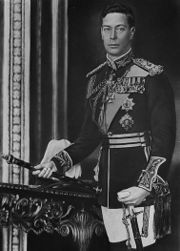King George VI
 George VI (Albert Frederick Arthur George Windsor) became King of the United Kingdom and the British Dominions on December 11, 1936 after his older brother, Edward VIII abdicated the throne. His Majesty George VI reigned as king through WWII, and is known for boosting national moral by refusing to leave London for safer lodging. In the years after WWII his health began to deteriorate, perhaps due to a combination of stress and excessive smoking. The life of George VI has been the subject of much public scrutiny, most recently in The King's Speech, a 2010 film that won the Academy Award for Best Picture. William Branham's Version of the EventsA close friend of King George VI's personal secretary was in attendance at William Branham's meetings in Fort Wayne, Indiana. It was during these meetings that this friend witnessed the healing of a man who had been bedridden with multiple sclerosis for 10 years. King George VI apparently learned about William Branham through this secretary, who relayed to him this story. In the late 1940s, William Branham was shocked to received a cablegram from King George VI that said:
Feeling it was not the Lord's will to travel to England at that time, William Branham replied that he would not be able to come, but would pray for the King from America, which he did. A while later, a second cablegram arrived from King George VI, again requesting William Branham to come and pray for him. In early April 1950, while en-route to a campaign in Finland, William Branham was able to finally meet and pray for King George VI in person. The Health of King George VIThe King had suffered from a duodenal ulcer, for which he had an operation in November 1917. In retelling how he prayed for King George VI, William Branham stated numerous times that King George VI contacted him because he was also afflicted with multiple sclerosis.[1] The only public evidence of King George VI having multiple sclerosis was his deteriorating health, and reports that during his 1947 trip to South Africa he looked sickly and slurred his words (although King George VI stuttered as a young man).[2] The slurring of words was attributed (and likely properly so) to his heavy drinking. In 1948 the public was advised that King George VI had a form of arteriosclerosis (hardening of the arteries) called Buerger's Disease, after which the King severely reduced his public appearances. Certain nerves to his legs were also severed in order to free him of some pain in standing.[3] In 1949, the King suffered an arterial blockage in his right leg, which was operated on in March 1949. The king opened the Festival of Britain from the steps of St Paul's on May 3 1950, but at subsequent public events that month, it was clear that he was not well. His condition deteriorated and on September 16, 1951, an exploratory operation showed he had cancer of the lung. He was not told of this conclusion, and believed the operation performed by Mr Price Thomas on September 23, 1051 was to remove his lung to free his bronchial tube. This series of operations occasioned intense public interest. [4] King George VI slowly began to regain his strength, then quietly passed away in his sleep on February 8, 1952 as the result of a coronary thrombosis. Concerns with William Branham's storyIt is unlikely that, if it had occurred, the public would have been aware the King George VI met with a faith healer. There are certainly no public records of any such visit. William Branham's indicates that his personal records contained a letter of thanks from King George VI for his prayers.[5] It is surprising that, given the amount of questions that have arisen on this website and others about the credibility of William Branham, the Branham family has not come forward with evidence such as this letter. The lack of any evidence does raise significant question as to whether there was a visit. While the public was informed of the King's health problems, there was never been any indication from any source that the King suffered from multiple sclerosis. Depending on which sources are given the most credibility, different people may arrive at different conclusions as to which disease William Branham actually prayed for. However, in the end that issue has little relevance. What is striking is that William Branham pronounced the king healed after his visit in April 1950, but the King's health was seen to have noticeably deteriorated immediately after a public appearance he made in early May 1950. Why would William Branham pray for him for mulitple sclerosis when he had been diagnosed in 1948 with severe heart disease and it was this disease which resulted in his death in 1952? Quotes
Footnotes
|